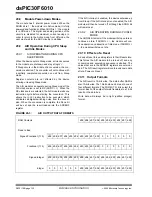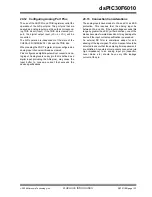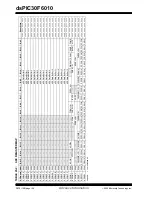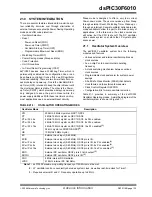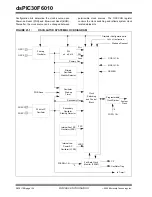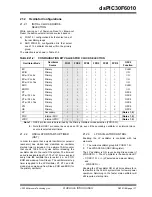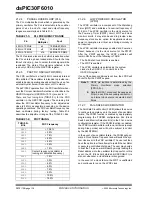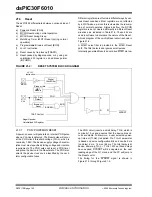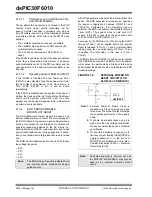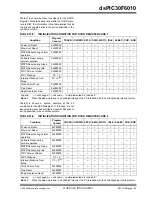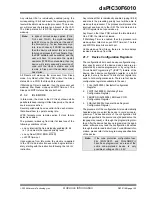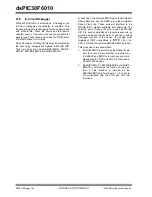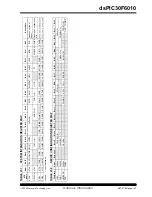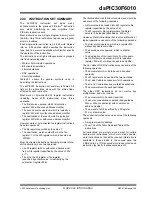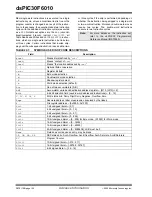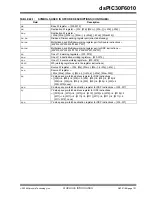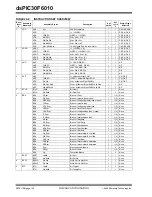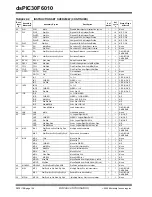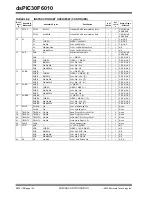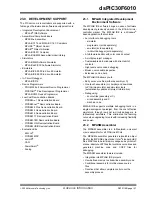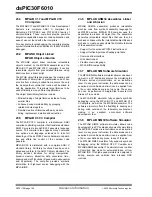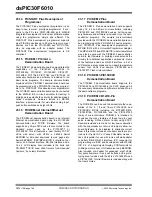
2004 Microchip Technology Inc.
Advance Information
DS70119B-page 145
dsPIC30F6010
Any interrupt that is individually enabled (using the
corresponding IE bit) and meets the prevailing priority
level will be able to wake-up the processor. The proces-
sor will process the interrupt and branch to the ISR.
The Sleep status bit in RCON register is set upon
wake-up.
All Resets will wake-up the processor from Sleep
mode. Any Reset, other than POR, will set the Sleep
status bit. In a POR, the Sleep bit is cleared.
If Watchdog Timer is enabled, then the processor will
wake-up from Sleep mode upon WDT time-out. The
Sleep and WDTO status bits are both set.
21.6.2
IDLE MODE
In Idle mode, the clock to the CPU is shutdown while
peripherals keep running. Unlike Sleep mode, the clock
source remains active.
Several peripherals have a control bit in each module,
that allows them to operate during Idle.
LPRC fail-safe clock remains active if clock failure
detect is enabled.
The processor wakes up from Idle if at least one of the
following conditions is true:
• on any interrupt that is individually enabled (IE bit
is ‘
1
’) and meets the required priority level
• on any Reset (POR, BOR, MCLR)
• on WDT time-out
Upon wake-up from Idle mode, the clock is re-applied
to the CPU and instruction execution begins immedi-
ately, starting with the instruction following the
PWRSAV
instruction.
Any interrupt that is individually enabled (using IE bit)
and meets the prevailing priority level will be able to
wake-up the processor. The processor will process the
interrupt and branch to the ISR. The Idle status bit in
RCON register is set upon wake-up.
Any Reset, other than POR, will set the Idle status bit.
On a POR, the Idle bit is cleared.
If Watchdog Timer is enabled, then the processor will
wake-up from Idle mode upon WDT time-out. The Idle
and WDTO status bits are both set.
Unlike wake-up from Sleep, there are no time delays
involved in wake-up from Idle.
21.7
Device Configuration Registers
The configuration bits in each device configuration reg-
ister specify some of the device modes and are pro-
grammed by a device programmer, or by using the In-
Circuit Serial Programming™ (ICSP™) feature of the
device. Each device configuration register is a 24-bit
register, but only the lower 16 bits of each register are
used to hold configuration data. There are four device
configuration registers available to the user:
1.
F
OS
c (0xF80000): Oscillator Configuration
Register
2.
FWDT (0xF80002): Watchdog Timer
Configuration Register
3.
FBORPOR (0xF80004): BOR and POR
Configuration Register
4.
FGS (0xF8000A): General Code Segment
Configuration Register
The placement of the configuration bits is automatically
handled when you select the device in your device pro-
grammer. The desired state of the configuration bits
may be specified in the source code (dependent on the
language tool used), or through the programming inter-
face. After the device has been programmed, the appli-
cation software may read the configuration bit values
through the table read instructions. For additional infor-
mation, please refer to the programming specifications
of the device.
Note:
In spite of various delays applied (T
POR
,
T
LOCK
and T
PWRT
), the crystal oscillator
(and PLL) may not be active at the end of
the time-out (e.g., for low frequency crys-
tals. In such cases), if FSCM is enabled,
then the device will detect this as a clock
failure and process the Clock Failure Trap,
the FRC oscillator will be enabled, and the
user will have to re-enable the crystal
oscillator. If FSCM is not enabled, then the
device will simply suspend execution of
code until the clock is stable, and will
remain in Sleep until the oscillator clock
has started.
Note:
If the code protection configuration fuse
bits (FGS<GCP> and FGS<GWRP>)
have been programmed, an erase of the
entire code-protected device is only
possible at voltages V
DD
≥
4.5V.
Содержание dsPIC30F6010
Страница 12: ...dsPIC30F6010 DS70119B page 10 Advance Information 2004 Microchip Technology Inc NOTES...
Страница 32: ...dsPIC30F6010 DS70119B page 30 Advance Information 2004 Microchip Technology Inc NOTES...
Страница 38: ...dsPIC30F6010 DS70119B page 36 Advance Information 2004 Microchip Technology Inc NOTES...
Страница 50: ...dsPIC30F6010 DS70119B page 48 Advance Information 2004 Microchip Technology Inc NOTES...
Страница 68: ...dsPIC30F6010 DS70119B page 66 Advance Information 2004 Microchip Technology Inc NOTES...
Страница 72: ...dsPIC30F6010 DS70119B page 70 Advance Information 2004 Microchip Technology Inc NOTES...
Страница 76: ...dsPIC30F6010 DS70119B page 74 Advance Information 2004 Microchip Technology Inc NOTES...
Страница 86: ...dsPIC30F6010 DS70119B page 84 Advance Information 2004 Microchip Technology Inc NOTES...
Страница 108: ...dsPIC30F6010 DS70119B page 106 Advance Information 2004 Microchip Technology Inc NOTES...
Страница 116: ...dsPIC30F6010 DS70119B page 114 Advance Information 2004 Microchip Technology Inc NOTES...
Страница 128: ...dsPIC30F6010 DS70119B page 126 Advance Information 2004 Microchip Technology Inc NOTES...
Страница 150: ...dsPIC30F6010 DS70119B page 148 Advance Information 2004 Microchip Technology Inc NOTES...
Страница 164: ...dsPIC30F6010 DS70119B page 162 Advance Information 2004 Microchip Technology Inc NOTES...
Страница 208: ...dsPIC30F6010 DS70119B page 206 Advance Information 2004 Microchip Technology Inc NOTES...
Страница 220: ...dsPIC30F6010 DS70119B page 220 Advance Information 2004 Microchip Technology Inc NOTES...
Страница 221: ...2004 Microchip Technology Inc Advance Information DS70119B page 221 dsPIC30F6010 NOTES...


